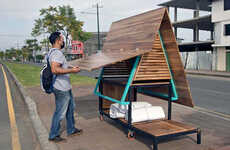
This Project Provides Sustainable Tiny Housing for the Homeless
Alyson Wyers — August 27, 2014 — Social Good
In an effort to provide housing for the homeless, a non-profit based out of Austin, Texas is looking to build microhomes as a shelter solution. The soon to be launched Community First Village project comes from Mobile Loaves & Fishes.
As microhousing is becoming an increasingly popular option sustainably and financially, Mobile Loaves & Fishes found their models only took six hours to build. According to Director of Development Donna Emery, they hope to move 240 of Austin's homeless population into the new community. She notes community is an essential part of feeling at home and "a tent in the woods is not going to solve what they desire most."
The non-profit organization has spent the past ten years performing research on housing for the homeless.
As microhousing is becoming an increasingly popular option sustainably and financially, Mobile Loaves & Fishes found their models only took six hours to build. According to Director of Development Donna Emery, they hope to move 240 of Austin's homeless population into the new community. She notes community is an essential part of feeling at home and "a tent in the woods is not going to solve what they desire most."
The non-profit organization has spent the past ten years performing research on housing for the homeless.
Trend Themes
1. Microhousing for the Homeless - Developing affordable and sustainable microhomes to provide housing solutions for the homeless.
2. Community-based Homeless Shelters - Creating supportive communities as a solution for homelessness, focusing on providing not just housing but also a sense of belonging.
3. Rapid Construction Techniques - Utilizing innovative construction methods to efficiently build homes in a short period of time.
Industry Implications
1. Non-profit Organizations - Non-profit organizations can leverage microhousing projects to address homelessness and create sustainable housing programs.
2. Construction and Real Estate - The construction and real estate industries can explore rapid construction techniques and design affordable microhome models for the homeless population.
3. Social Services - Social service organizations can support community-based homeless shelters by providing resources, counseling, and support programs.
6.8
Score
Popularity
Activity
Freshness























